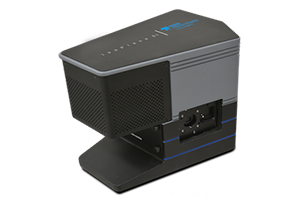Dr. Kenan Gundogdu
North Carolina State University, USA
Background
Dr. Kenan Gundogdu’s research group in the Physics Department at North Carolina State University studies ultrafast dynamics and develops new spectroscopy methods for studying semiconductors. These nonlinear optical spectroscopy techniques allow Dr. Gundogdu’s group to investigate the structural and electronic dynamics in condensed matter systems. The group investigates organic electronics, hybrid semiconducting systems, and low-dimensional materials such as graphene and transition metal dichalcogenides (TMDCs), which — because of their unique electronic and mechanical properties at atomic-scale thicknesses — are candidates for next-generation materials for energy harvesting, spintronics, and photonics applications.

Figure 1: (a) Time-resolved differential transmission spectrum with 500 ns square-wave photoexcitation (green dashed lines). Spectral line-outs at various times during EHP formation (b) and decay (c). (d) Temporal line-outs are shown at A (black) and B (green) exciton energies, and at energies corresponding to dense plasma (red) and conduction band (yellow) states affected by bandgap renormalization. The temperature (blue dashed) dynamics for the material center is shown alongside the differential transmission. All energy channels are normalized to the steady-state EHP intensity averaged between 300 and 500 ns. Data courtesy of Dr. Kenan Gundogdu (North Carolina State University). First published in DOI: 10.1021/acs.nanolett.8b04408.
Challenge
Dr. Gundogdu and his research group are specifically focused on dynamics that are relevant to solar energy conversion. Research questions include the role of coherent and incoherent electron motion in energy conversion, how energy transport happens in interfaces that involve inorganic and organic materials, and the identification of the physical properties of optical excitations in such hybrid materials.rnrnDr. Gundogdu and his colleagues have authored a paper titled “Dense Electron-Hole Plasma Formation and Ultra-Long Charge Lifetime in Monolayer MoS2 via Material Tuning” that details their recent study of condensed matter systems and electron dynamics in optically excited 2D semiconductors (Bataller et al. Nano Lett., Just Accepted Manuscript, DOI: 10.1021/acs.nanolett.8b04408, Web Publication Date: 04 Jan 2019).rnrnIn this work, researchers used several different spectroscopic methods to study monolayer MoS2, a TMDC material. Raman spectroscopy was utilized to measure the band structure change in MoS2 as a function of temperature; time-resolved photoluminescence and differential transmission spectroscopies were employed to measure the formation and evolution of electron-hole plasma in the 2D material.
FERGIE is easy to use, install, configure, and set up. FERGIE offers a lot of convenience, all in one system.
Solution
Dr. Gundogdu’s research group used the FERGIE system (previous version of the IsoPlane 81) to obtain time-resolved differential transmission measurements found in the previously mentioned publication. White light from an optical parametric amplifier pumped by an amplified femtosecond laser was used as the probe signal. A microscope objective focused the probe light and, after passing through the sample and exiting the vacuum chamber, the light was collected by a second microscope objective and imaged onto the FERGIE’s entrance slit.rnrnOperating in its kinetics spectroscopy mode, FERGIE was electronically triggered to acquire every probe pulse. For each time step, alternating probe and pump+probe spectra from FERGIE were recorded and then processed to yield ΔT/T. The researchers found the FERGIE system easy to use, with simple installation, configuration and set-up. They also found the CUBE attachments useful, offering a range of different spectroscopy options. This allowed for fast Raman spectroscopy measurements, with the FERGIE providing a convenient solution within one system.

